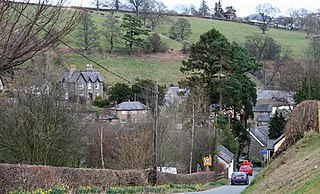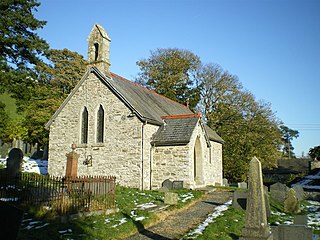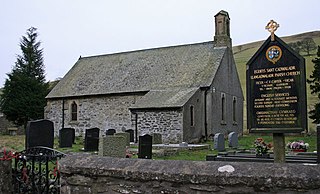
John Silas Evans, Rev. (1864-1953) was a Welsh astronomer and priest. He became a senior figure within the Anglican Church in Wales and is well known for his astronomical writing published in Welsh and English.

John Silas Evans, Rev. (1864-1953) was a Welsh astronomer and priest. He became a senior figure within the Anglican Church in Wales and is well known for his astronomical writing published in Welsh and English.
John Silas Evans was born in the village of Pencarreg in Carmarthenshire, south-west Wales. He attended Alcwyn's School in Carmarthen and a grammar school in Lampeter before studying at St David's College, Lampeter. He graduated with a bachelor's degree in theology in 1885 and won prizes for science and the Welsh language.[1] Evans lectured at a college in Coventry for a year before his religious ordination in 1887.
John Silas Evans had a varied and successful clerical career within the Anglican Church. He was first ordained as a deacon at St. Asaph Cathedral, Denbighshire, in 1887 and priested in 1888. Evans remained based in Welsh parishes, serving as a curate of Dyserth, Denbighshire, between 1887–90 and of Rhos-ddu between 1890 and 1895. He served as a vicar of St. Asaph (1895-1901) and of the parish of Gyffylliod (1901-9), before settling in his role as vicar of the village church in Llanrhaeadr-ym-Mochnant. [1] Evans remained in this remote parish community in the Berwyn Mountains for nearly three decades, until 1938.[2]

Canon Silas Evans had a profound interest in the history of the parish of Llanrhaeadr-ym-Mochnant, where he served as vicar for most of his life. He lived in the church vicarage, one of the largest vicarages in the St. Asaph bishopric, set in a two-acre garden. [2] This was also the residence of another illustrious historical personage associated with the area, Dr William Morgan, who served as vicar of St Dogfans between 1578 and 1588 [3] and translated the Bible into the Welsh language.
Evans expressed his interest in the social, archeological and religious history of his parish in a Welsh language publication entitled Hanes Plwyf Llanrhaeadr ym Mochnant ('The History of the parish of Llanrhaeadr-ym-Mochnant') first published in 1940 and translated into English by Ceinwen Edwards in 1998. This parish history includes facts and anecdotes about salient local landmarks such as the nearby Pistyll Rhaedr waterfall, and a number of nearby standing stones (menhirs) and barrows. As well as discussing the area's ancient, druidic history, Evans touches on aspects of village's religious life, folklore and engagement with ancient healing magic, such as the use of elder bark to heal cancerous skin growths. [4]
Evans wrote at length about the interior of the Church of St Dogfans, describing it as 'beautiful' and noting 'that the building is very old, though, naturally, it has been restored many times." [5] One of the adaptations of the church interior that Evans was personally responsible for included the painting of stars and planets on the ceiling of the Church. [3]
On 31 January 1923 Evans was elected to the membership of the British Astronomical Association. [6] He was proposed by Arthur Mee. [7] On 9 November 1923 Evans was elected to the fellowship of the Royal Astronomical Society. [8] These elections followed a life-time's interest in science and astronomy in evidence since his student days. One of Evans' most popular books, The Marvels of the Sky: An Introduction to Popular Astronomy (1921), was written while he lived in the vicarage in Llanrhaeadr. In the author's preface, Evans dedicates his book ‘to my constant and faithful companion, my old Refractor telescope’. [9] Evans' telescope was a four-inch telescope manufactured by the London optician Charles Tulley. [10] The other astronomical writing by Evans is the Welsh language text Seryddiaeth a seryddwyr ('Astronomy and Astronomers'), 1923.
Another format that Evans used to express his faith and interest in astronomy, were his sermons. He published Ad Astra, a collection of eight astronomical sermons concerned with the relationship between science and religion, in 1930. In his introduction to the book Evans defines these rhetorical pieces as 'a short series of sermons, or addresses, of an astronomical character, on the religious aspect of the science.’ [11] The first sermon, 'In the Beginning, God', explores the conflict between science and religion. Evans discusses several controversial points, such as the implications that scientific estimates for age of the planet hold for the story of creation in Genesis and the implications that Charles Darwin's Theory of Evolution hold for Christian faith. Subsequent sermons explore astronomical themes both within the context of Christianity and in a broader, secular context. For example, his sixth sermon, 'Are the Planets Inhabited?’ discusses the possibility of alien life forms [12] and his seventh sermon, ‘Which was the Star of Bethlehem?' discusses the scientific basis, as well as the broader spiritual and metaphorical meaning of this well-known Star. In 1949 Evans published Myfyrion min yr hwyr, (Evening Reflections) a volume of Welsh language preaching and addresses.
Evans' work participates in a tradition of famous scientific churchmen such as John Donne, the metaphysical poet and Dean of St. Paul's Cathedral, whose well-known interest in astronomy and the Scientific Revolution found expression in his religious sermons as well as his lyric poetry. Evans enjoyed a high reputation for his sermons within his lifetime and preached at St. Paul's Cathedral in London in 1939. According to the author Mary Gwendoline Ellis, Evans 'had an exceptional memory and he could conduct church services almost completely from memory'. [13]

In 1938 Evans retired and moved to Aberystwyth, reputedly to be in close proximity to the National Library of Wales. [13] He named his house in Aberystwyth 'Ad Astra', after the name of his book. Subsequently, Evans returned to his native village of Pencarreg where he died on 19 April 1953. He is buried in the graveyard of Pencarreg church. [13]

William Morgan was a Welsh Bishop of Llandaff and of St Asaph, and the translator of the first version of the whole Bible into Welsh from Greek and Hebrew.

Llanrhaeadr-ym-Mochnant is a village, community and an ecclesiastical parish in the extreme north of Powys, Wales; about 9 miles west of Oswestry and 12 miles south of Llangollen, on the B4580. It lies near the foothills of the Berwyn mountains on the river Rhaeadr. At the top end of the valley is the Pistyll Rhaeadr waterfall, one of the Seven Wonders of Wales in the old rhyme. One mile north of the town is the hill Moel Hen-fache. The community includes the hamlet of Llanarmon Mynydd Mawr.

Henry Thomas Edwards was a Welsh preacher.

Llansilin is a village and local government community in Montgomeryshire, Powys, Wales, 5 miles (8 km) west of Oswestry. The community, which includes Llansilin village, a large rural area and the hamlets of Moelfre and Rhiwlas as well as the remote parish of Llangadwaladr, had a population of 648 at the 2001 census, increasing to 698 at the 2011 Census. There is also an electoral ward including the nearby village of Llanrhaeadr-ym-Mochnant with a population of 2,295.

The Liverpool Astronomical Society was founded in 1881 in Liverpool, England, as a society to promote and coordinate amateur astronomy.
Thedore Price was a Welsh Anglican clergyman and academic. He served as Principal of Hart Hall, Oxford for 18 years and was also a prebend of Westminster Abbey. However, after falling out with his patron, John Williams, he sided with William Laud and was reputed to have converted from Anglicanism to Roman Catholicism at the end of his life.
Thomas Thomas was a Welsh Anglican clergyman. He was noted for his parish ministry in Caernarfon, particularly for his educational work in building schools and helping to found the North Wales Training College.
Thomas Llewellyn Thomas was a Welsh Anglican clergyman and scholar of the Welsh language. He wrote poems in English, Latin and Welsh and worked on a Basque translation of the Old Testament. He was a Fellow of Jesus College, Oxford for twenty-five years, including fifteen years as Vice-Principal, but failed to be elected Principal in 1895, losing out to John Rhys.
John Dudley Davies is a former Anglican Bishop of Shrewsbury. During his tenure the post changed from suffragan bishop to area bishop with the institution of area bishops in 1992.
Charles Edwards was a Welsh Puritan cleric and writer, whose works made him a major figure in the literary history of Welsh Puritanism.

Walter Davies, commonly known by his bardic name Gwallter Mechain, was a Welsh poet, editor, translator, antiquary and Anglican clergyman.

Llanarmon Mynydd Mawr, occasionally referred to as Llanarmon Fach, is an isolated rural parish in Powys, Wales. It was formerly in Denbighshire, and from 1974 to 1996 was in the county of Clwyd. It measures 2 square miles (5 km2) and has a population of 40.

Thomas Vowler Short was an English academic and clergyman, successively Bishop of Sodor and Man and Bishop of St Asaph.

Llangadwaladr, formerly spelt Llancadwaladr in some sources, is an isolated mountain parish in Powys, Wales. It was formerly in the historic county of Denbighshire, and from 1974 to 1996 was in Clwyd. Some 7 miles west of the nearest town, Oswestry, it covers an area of sparsely settled hill farming country around the valley of the Afon Ysgwennant beneath Gyrn Moelfre.
Robert Wilson Evans was an English cleric and author, Archdeacon of Westmorland from 1856 until the year before his death a decade later.
Alis ferch Gruffudd ab Ieuan ap Llywelyn Fychan or Alis Wen was a 16th-century poet who wrote in Welsh. She wrote several englynion on matters of her personal and family life, and a cywydd aimed at reconciling two men.

Mochnant was a medieval cantref in the Kingdom of Powys.
John Davies was a Welsh missionary and school teacher. His family were from the Llanfihangel-yng-Ngwynfa area of Montgomeryshire. Having received some education in one of "Madam" Bridget Bevan's schools, he became a teacher in Thomas Charles of Bala's circulating schools at Llanrhaeadr-ym-Mochnant, Machynlleth and Llanwyddelan. He heard of the work established by the London Missionary Society in Tahiti through his Calvinistic Methodist connections, and volunteered to join the work. He left for the island in May 1800 and remained there for most of the next 55 years. He married twice: Sophia Browning in 1810 and Mary Ann Bicknell in 1824. Davies became superintendent of a school at Papara, established by the London Missionary Society. He also encouraged the setting up of mission schools in Fiji.
Richard Langford was a Welsh Anglican priest in the late 17th and early 18th centuries.
Thoms Runcorn was a Welsh Anglican priest in the 16th century.